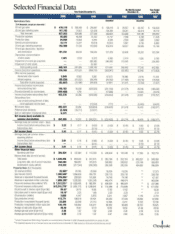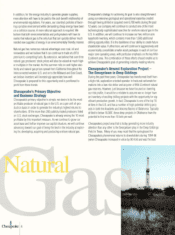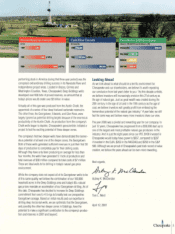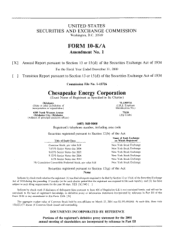Chesapeake Energy 2000 Annual Report Download - page 6
Download and view the complete annual report
Please find page 6 of the 2000 Chesapeake Energy annual report below. You can navigate through the pages in the report by either clicking on the pages listed below, or by using the keyword search tool below to find specific information within the annual report.
In addition, for the energy industry to generate greater supplies,
more atfention will have to be paid to the cost-benefit relationship of
environmental regulations. For years, our country's policies of favor-
ing a pristine environment while demanding cheap energy have been
on a collision course. A more rational approach is required. We
believe that both environmentalists and policymakers will have to
realize that natural gas is the only fuel that can quickly deliver much
needed new supplies of energy in an environmentally friendly manner.
Natural gas has numerous natural advantages over coal, oil and
renewables and we believe that it can continue to trade at a BTU
premium to competing fuels. By extension, we believe that over time
natural gas producers' stock prices will also be valued at much high-
er multiples in the market. As this summer rolls on and higher elec-
tricity and natural gas prices spread from California throughout the
interconnected western U.S. and on to the Midwest and East Coast,
we believe investors will increasingly appreciate how well
Chesapeake is prepared for this opportunity and is positioned to
profit from these trends.
Chesapeake's Primary Objective
and Business Strategy
Chesapeake primary objective is simple: we desire to be the most
profitable producer of natural gas in the U.S. on a per-unit-of-pro-
duction basis in order to generate the industry's highest returns to
shareholders. Of the more than 200 publicly traded producers listed
on U.S. stock exchanges, Chesapeake is already among the 10 most
profitable by this important measure. As we continue to grow our
asset base and further improve our capital structure, we will continue
advancing toward our goal of being the best in the industry at explor-
ing for, developing, acquiring and producing onshore natural gas.
Chesapeake's strategy for achieving its goal is also straightforward:
using our extensive geological and operational expertise created
through having drilled or acquired over 6,700 wells during the past
12 years, our company will continue to conduct one of the most
technologically sophisticated searches for onshore natural gas in the
U.S. In addition, we will continue to increase our two million acre
leasehold inventory, which contains more than 1,500 additional
drilling opportunities. It is the backbone of our ability to create future
shareholder value. Furthermore, we will continue to aggressively and
economically consolidate smaller asset packages in each of our tour
major core operating areas, with particular emphasis on the key Mid-
Continent area. The combination of these efforts should enable us to
achieve Chesapeake's goal of generating industry-leading returns.
Chesapeake's P4ewest Exploration Project
The Georgetown in Deep Giddings
During the past three years, Chesapeake has transformed itself from
a high-risk, exploration oriented operator in fractured carbonate for-
mations into a low-risk driller and acquirer of Mid-Continent natural
gas reserves. However, just because we have focused on lowering
our risk profile, it would be a mistake to assume we no longer have
an inventory of exciting drilling projects with the opportunity for sig-
nificant production growth. In tact, Chesapeake is one of the top 10
drillers in the U.S. and has a number of high-potential drilling proj-
ects in both the Anadarko and Arkoma Basins of Oklahoma. Typically
drilled to below 15,000', these deep projects in Oklahoma have the
potential to find more than 10 bcte per well.
Chesapeake's project area that is today generating more industry
attention than any other is the Georgetown play in the Deep Giddings
Field in Texas. Many of you may recall that the springboard for
Chesapeake's phenomenal returns to shareholders during 1994-96
(when Chesapeake increased in value by 90-fold and was the best
A
Chesapeake 4



















